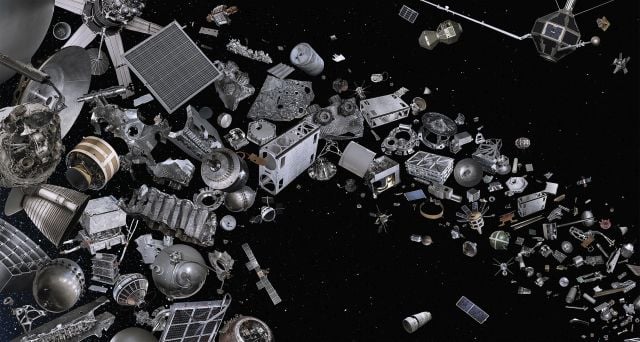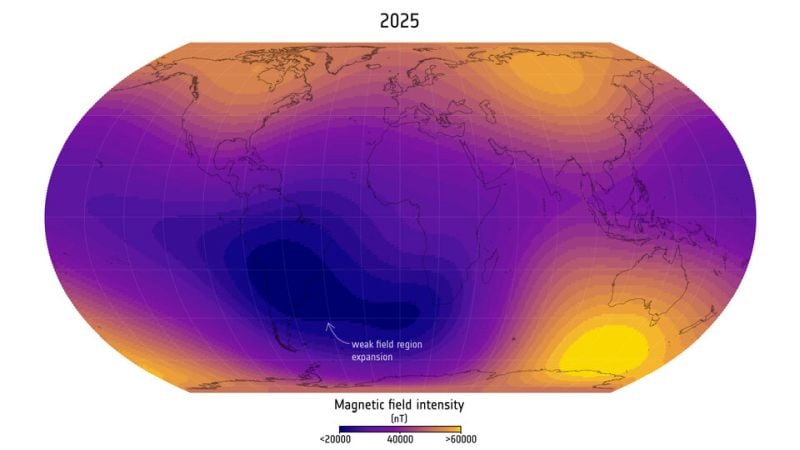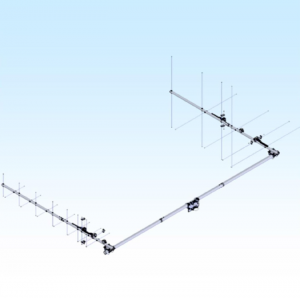
AMSAT News Service
ANS-299
October 26, 2025
In this edition:
* AMSAT President Outlines Future Directions
* Symposium Videos Available on YouTube
* Is AO-7 Still the Oldest Satellite?
* Amateur Radio Receiver Reveals Global Satellite Privacy Issue
* Changes to AMSAT-NA TLE Distribution
* Russian Cosmonauts Conduct Spacewalk Outside ISS
* ARISS News
* AMSAT Ambassador Activities
* Satellite Shorts From All Over
The AMSAT® News Service bulletins are a free, weekly news and information service of AMSAT, The Radio Amateur Satellite Corporation. ANS publishes news related to Amateur Radio in Space including reports on the activities of a worldwide group of Amateur Radio operators who share an active interest in designing, building, launching and communicating through analog and digital Amateur Radio satellites.
The news feed on https://www.amsat.org publishes news of Amateur Radio in Space as soon as our volunteers can post it.
Please send any amateur satellite news or reports to: ans-editor [at] amsat.org
You can sign up for free e-mail delivery of the AMSAT News Service Bulletins via the ANS List; to join this list see: https://mailman.amsat.org/postorius/lists/ans.amsat.org/
AMSAT President Outlines Future Directions
At the Annual General Meeting of AMSAT members, held as part of the AMSAT Symposium in Phoenix, Ariz. last weekend, newly elected AMSAT President Drew Glasbrenner, KO4MA, outlined some future directions for the organization.
Noting that membership in organizations and voluntary associations of all types has been declining across the board, in all areas of society, Glasbrenner suggested a two-pronged approach.
First, reduce the cost per member. AMSAT has already made major steps in that direction, by closing the office and changing to an all-volunteer administration, and also by changing the AMSAT Journal from print to a digital publication. The organization should seek more opportunities to economize.
Second, increase membership by creating a strategy to actively seek and invite new hams. The Board has just approved a free student membership to bring young hams into the organization. Reinstating a College Activity Night on the satellites, an AMSAT Youth Net, and publicizing youth satellite activities are priorities. Another possibility might be a two-tiered membership structure with a low-fee introductory membership.

AMSAT President Drew Glasbrenner, KO4MA, addresses the 2025 Annual General Meeting in Phoenix (Credit: David Vine, WA1EAW, AMSAT Director of Public Relations)
Glasbrenner also noted that government budget cuts have caused NASA to eliminate the CubeSat Launch Initiative program (CSLI), which provided free launch opportunities to educational projects. AMSAT has benefited from CSLI, but has also purchased commercial launches in the past. He indicated that AMSAT should not wait to see if CSLI is reinstated or replaced with a similar program, but that the organization should move forward to fund commercial launches for GOLF-Tee and Fox Plus satellites that are nearing readiness in coming months.
Another challenge facing AMSAT is that it is becoming increasingly difficult to operate in Low Earth Orbit (LEO). While orbital debris regulations forbid launches to higher orbits without meeting stringent technical requirements for deorbiting, reentry devices are largely unavailable or unproven. The GOLF program is meant to address this, but launches to higher orbits are also difficult to find. Future rules may mandate propulsion for collision avoidance in LEO.
A strategy to meet these orbital challenges is to focus on developing amateur radio payloads that can fly on other satellites. The Italian Greencube satellite, IO-117, was an example. To take advantage of these opportunities, AMSAT engineers must focus on developing payloads as a series, rather than as single projects, so that units are “on the shelf” and available on short notice. The SDR Gen2 transverter board – an updated version of the units flown on HuskySat and MESAT1 – is a major step in this direction, as is the updated PacSat board under development. The GOLF and Fox Plus programs are also being crafted to create satellites in a series with iterative improvements and an up-tempo launch cadence.
Finally, Glasbrenner called for strengthening international collaboration with other AMSAT organizations around the world, as well as establishing mechanisms for strategic planning at the Board of Directors level. His address was received enthusiastically by those in attendance.
[ANS thanks Mark Johns, KØJM, News Service Senior Editor, for the above information.]
AMSAT Remove Before Flight Key Tags Now Available
Yes, These are the Real Thing!
Your $20 Donation Goes to Help Fly a Fox-Plus Satellite
Includes First Class Postage (Sorry – U.S. Addresses Only)
Order Today at https://www.amsat.org/product/amsat-remove-before-flight-keychain
Symposium Videos Available on YouTube
Video of presentations at the 2025 AMSAT Space Symposium and Annual General Meeting in Phoenix, Arizona, USA are now available on AMSAT’s YouTube channel.
Friday, October 17: https://www.youtube.com/watch?v=oAC9_Uh2ys4
Saturday, October 18: https://www.youtube.com/watch?v=W0K9cHCz9Fw
Embedded hyperlinks are provided for direct access to the beginning of each presentation.
Friday, October 17*
| Start | Speaker | Topic |
| 1:00 PM | Introduction/Announcements | Robert Bankston, KE4AL, Outgoing President |
| 1:05 PM | AMSAT President Welcome | Drew Glasbrenner, KO4MA, Incoming President |
| 1:15 PM | Cameron Castillo, KJ7ILB | ASCENT Team Propulsion |
| 1:45 PM | Jim McCullers, WA4CWI | Oscar to OsTrax |
| 2:15 PM | Andrew Robinson, KA3WDW | FoxPlus Mechanical Layout & Design |
| 3:00 PM | Heimir Thor Sverrisson, W1ANT | Extending Command and Control for GOLF |
| 3:30 PM | Frank Bauer, KA3HDO | ARISS |
| 4:00 PM | Frank Karnauskas, N1UW | Youth Initiative |
| 4:30 PM | Jim White, WD0E | ARDC |
Saturday, October 18*
| Start | Speaker | Topic |
| 8:00 AM | Alan Johnston, KU2Y | CubeSatSim Update & Demonstration |
| 9:00 AM | Agastya Bose, KJ5MSH | CubeSatSim, UT Dallas – Workshop Reflections |
| 9:15 AM | Larry Ryan, W7DGP | Building the CubeSatSim |
| 9:30 AM | Frederic Raab, KK6NOW | Bridging Orbit and Classroom: SatNOGS/CubeSatSim |
| 10:15 AM | Burns Fisher, WB1FJ | Telemetry for FoxPlus & GOLF CubeSats |
| 10:45 AM | Burns Fisher, WB1FJ | A New Use for Fox & MESAT-1 Whole Orbit Data Algorithm |
| 11:15 AM | Kipton Moravec, AE5IB | GOLF-TEE Electrical Power Supply (EPS) |
| 1:00 PM | Jerry Buxton, N0JY | Engineering / GOLF-TEE Update |
| 2:00 PM | Mike Moore, K4MVM | FoxPlus Update |
| 2:30 PM | Jerry Buxton, N0JY | Future Systems |
| 3:00 PM | Drew Glasbrenner, KO4MA | Annual General Meeting |
* All times are U.S. Mountain Standard Time (UTC-7). Arizona does not observe Daylight Savings Time.
[ANS thanks David Vine, WA1EAW, AMSAT Director of Public Relations, for the above information.]
Is AO-7 Still the Oldest Satellite?
AMSAT-OSCAR 7, or AO-7, is the second Phase 2 amateur radio satellite constructed by the Radio Amateur Satellite Corporation (AMSAT). It was launched into Low Earth Orbit on November 15, 1974 and remained operational until a battery failure in 1981. After 21 years of apparent silence, the satellite was heard again on June 21, 2002 – 27 years after launch, and it continues to be used by amateurs daily even now. For a couple decades, AMSAT has been able to proudly boast that this bird is the oldest operating satellite in space.
However, that record has been challenged. After 47 years of silence, LES-1, a satellite launched by the U.S. Air Force and MIT’s Lincoln Laboratory in 1965, began transmitting again. Its signals were detected by Phil Williams, G3YPQ, from North Cornwall in southwest England on 18 December 2012, verified by other members of Hearsat group, Flávio A. B. Archangelo, PY2ZX, in Brazil on 22 December 2012, and Matthias Bopp, DD1US, in Germany on 27 December 2012.
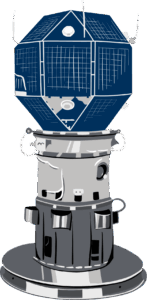
LES-1 (Illustration courtesy of MIT)
According to Williams, LES-1 was determined to be tumbling with a rotation rate of once every four seconds, as determined by distinctive fading of the signals. It is possible that, after 47 years, the batteries failed in a manner that allows them to carry charge directly through to the transmitter on 237 MHz, allowing the satellite to resume transmissions when it is in sunlight. The satellite continues to be operational as tracked by the SatNOGS network.
[ANS thanks Daily Galaxy for the above information. Read the full article at https://dailygalaxy.com/2025/10/lost-for-50-years-zombie-satellite-signals/.]
The 2025 AMSAT President’s Club Coins Are Here!
Celebrating the 40th Anniversary of Amateur Radio on Human Spaceflight
Help Support GOLF and Fox Plus.
Join the AMSAT President’s Club today!
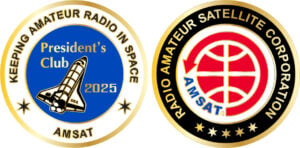
Amateur Radio Receiver Reveals Global Satellite Privacy Issue
Imagine that you can buy a device for a few hundred dollars and listen in on private conversations, military negotiations, and even intercept important commands for power systems around the world. This is not a scene from a spy movie, but harsh reality. The vulnerability was accidentally discovered by researchers from the University of California and the University of Maryland. For three years, they listened in on secret military and private communications. The result was astonishing: almost half of all satellite transmissions were completely unencrypted.
Analysis of the intercepted traffic showed that the following was transmitted over the open airwaves:
- Private phone calls and SMS messages from T-Mobile customers.
- Wi-Fi data from airplanes.
- Critical commands for managing power grids and oil platforms.
- Military and police reports revealing troop locations and details of secret missions.
Governments and corporations rely on these systems, considering them to be reliably secure. In fact, the risks are much more serious than just a breach of confidentiality. This vulnerability can be used as a weapon to track troop movements, sabotage vital infrastructure, and steal data on a massive scale.
The most disastrous aspect is that scientists analyzed only 15% of the total traffic, meaning that the actual scale of the problem could be much greater.
[ANS thanks E.Mike McCardel, AA8EM, and Ivan Hrinko of Universe Space Tech for the above information. Read the full article at https://universemagazine.com/en/amateur-radio-receiver-reveals-global-satellite-communications-disaster/.]
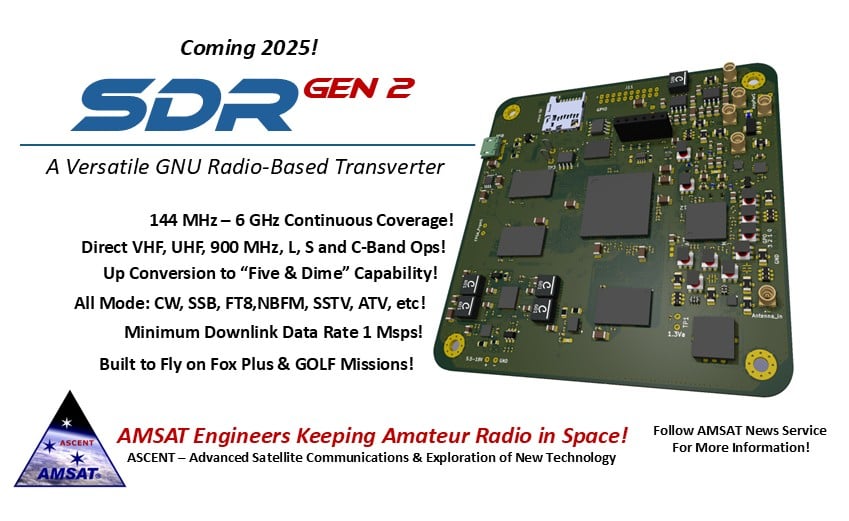
Changes to AMSAT TLE Distribution for October 24, 2025
Two Line Elements or TLEs, often referred to as Keplerian elements or keps in the amateur community, are the inputs to the SGP4 standard mathematical model of spacecraft orbits used by most amateur tracking programs. Weekly updates are completely adequate for most amateur satellites. TLE bulletin files are updated daily in the first hour of the UTC day. New bulletin files will be posted immediately after reliable elements become available for new amateur satellites. More information may be found at https://www.amsat.org/keplerian-elements-resources/.
The following satellites have been removed from this week’s AMSAT TLE distribution:
- NOAA-15 NORAD Cat ID 25338 Spacecraft decommissioned 19 August 2025
- NOAA-19 NORAD Cat ID 33591 Spacecraft decommissioned 13 August 2025
- UPMSat 2 NORAD Cat ID 46276 Decayed from orbit on or about 11 October 2025
- LEDSAT NORAD Cat ID 49069 Decayed from orbit on or about 15 October 2025
- CAS-4A NORAD Cat ID 42761 Decayed from orbit on or about 9 October 2025
- CAS-4B NORAD Cat ID 42759 Decayted from orbit on or about 14 October 2025
The following satellites have been added to this week’s AMSAT TLE distribution:
- BOTAN NORAD Cat ID 65942 437.379 MHz
- GHS-01 NORAD Cat ID 65733 437.090 MHz
- Dragonfly NORAD Cat ID 65729 437.375 MHz
- RSP-03 NORAD Cat ID 65732 437.050 MHz
[ANS thanks Joe Fitzgerald, KM1P, AMSAT Orbital Elements Manager, for the above information.]
Russian Cosmonauts Conduct Spacewalk Outside ISS
Two Russian cosmonauts are back inside the International Space Station (ISS) after conducting a spacewalk to install a semiconductor materials experiment, as well as retrieve and jettison a no-longer-needed camera from the exterior of the orbiting complex.
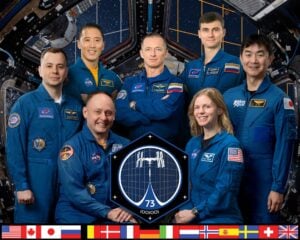
Expedition 73 crew from three different space agencies. Seated in the front row are NASA astronauts Mike Fincke and Zena Cardman. In the back row from left are, Roscosmos cosmonaut Oleg Platonov; NASA astronaut Jonny Kim; Roscosmos cosmonauts Sergey Ryzhikov and Alexey Zubritsky; and JAXA (Japan Aerospace Exploration Agency) astronaut Kimiya Yui. (Credit: NASA/Josh Valcarcel)
Expedition 73 commander Sergey Ryzhikov and flight engineer Alexey Zubritsky, both with Russia’s federal space corporation Roscosmos, marked the end of their first extravehicular activity (EVA) together.
Ryzhikov and Zubritsky installed the drum-shaped unit, ran power cables and mounted a swappable cassette. The experiment is intended to demonstrate the ability to produce very thin materials — too thin to be made reliably on Earth — that can go from the microgravity environment of outer space to being used in semiconductors.
Their primary task completed, Ryzhikov and Zubritsky then made their way to the Zvezda service module to remove and dispose of a high-definition television system that was originally a part of a Canadian commercial payload. Zubritsky then stood a the end of the European Robotic Arm and tossed the camera overboard, toward the rear of the space station, ensuring it would not come back in contact with the outpost.
[ANS thanks space.com for the above information. See the full article at http://bit.ly/4nepOWH.]
ARISS News
Amateurs and others around the world may listen in on contacts between amateurs operating in schools and allowing students to interact with astronauts and cosmonauts aboard the International Space Station. The downlink frequency on which to listen is 145.800 MHz worldwide.
RECENTLY COMPLETED
Colegio de Cultura Popular, Bogotá, Colombia, telebridge via AB1OC
The ISS callsign was presently scheduled to be NA1SS
The scheduled crewmember was Zena Cardman KJ5CMN
The ARISS mentor was VE6JBJ
Contact was successful: Thu 2025-10-23 13:46:10 UTC 63 degrees maximum elevation
Congratulations to the Colegio de Cultura Popular students, Zena, mentor VE6JBJ, and telebridge AB1OC!
18th Primary School of Larissa, Larissa, Greece, Telebridge via K6DUE
The ISS callsign was presently scheduled to be NA1SS
The scheduled crewmember was Mike Fincke KE5AIT
The ARISS mentor was IKØWGF
Contact was successful: Fri 2025-10-24 08:04:47 UTC 33 degrees maximum elevation
Congratulations to the 18th Primary School of Larissa students, Mike, mentor IKØWGF, and telebridge K6DUE!
Terre Haute Children’s Museum, Terre Haute, Indiana, direct via W9UUU
The ISS callsign was presently scheduled to be NA1SS
The scheduled crewmember was Jonathan (Jonny) Kim KJ5HKP
The ARISS mentor was KD8COJ
Contact was completed: Sat 2025-10-25 13:45:00 UTC 52 degrees maximum elevation
Watch for Livestream at https://live.ariss.org
UPCOMING
Miejski Dom Kultury w Koło (abrr. MDK), Koło, Poland, Telebridge via AB1OC
The ISS callsign is presently scheduled to be NA1SS
The scheduled crewmember is Zena Cardman KJ5CMN
The ARISS mentor is SP3QFE
Contact is go for: Wed 2025-10-29 10:36:06 UTC 49 degrees maximum elevation
Australian Air League, Adelaide, South Australia, Australia, telebridge via VK4ISS
The ISS callsign is presently scheduled to be NA1SS
The scheduled crewmember is Mike Fincke KE5AIT
The ARISS mentor is VK4KHZ
Contact is go for: Fri 2025-10-31 09:59:01 UTC 39 degrees maximum elevation
Q-Tech conference – Wavell State High School, Wavell Heights, Queensland, Australia, telebridge via VK4ISS
The ISS callsign is presently scheduled to be NA1SS
The scheduled crewmember is Jonathan (Jonny) Kim KJ5HKP
The ARISS mentor is VK4KHZ
Contact is go for: Sat 2025-11-01 09:10:47 UTC 86 degrees maximum elevation
Many times a school may make a last minute decision to do a Livestream or run into a last minute glitch requiring a change of the URL but we at ARISS may not get the URL in time for publication. You can always check https://live.ariss.org/ to see if a school is Livestreaming.
As always, if there is an EVA, a docking, or an undocking; the ARISS radios are turned off as part of the safety protocol:
Powering OFF Oct 28, 10:15 UTC, Powering ON Oct 29, 09:05 UTC
The crossband repeater continues to be active (145.990 MHz up {PL 67} & 437.800 MHz down), If any crewmember is so inclined, all they have to do is pick up the microphone, raise the volume up, and talk on the crossband repeater. So give a listen, you just never know.
Packet operations continue to be active (145.825 MHz up & down). HamTV is configured (2395.00 MHz).
Note, all times are approximate. It is recommended that you do your own orbital prediction or start listening about 10 minutes before the listed time.
The latest information on the operation mode can be found at https://www.ariss.org/current-status-of-iss-stations.html
The latest list of frequencies in use can be found at https://www.ariss.org/contact-the-iss.html
[ANS thanks Charlie Sufana, AJ9N, one of the ARISS operation team mentors for the above information.]
Want to fly the colors on your own grid expedition?
Get an AMSAT car flag and other neat stuff from our Zazzle store!
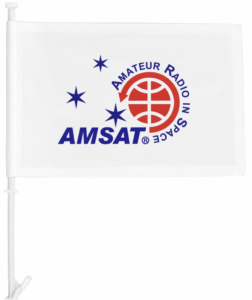
25% of the purchase price of each product goes towards Keeping Amateur Radio in Space
AMSAT Ambassador Activities
AMSAT Ambassadors provide presentations, demonstrate communicating through amateur satellites, and host information tables at club meetings, hamfests, conventions, maker faires, and other events.
Ambassador Clint Bradford, K6LCS, writes:
AMSAT Ambassadors spread the word on amateur satellites – world-wide! If we’re not local to your club or convention, we’ll Zoom a show for you! An email I recently received:
“Clint,
“I wanted to thank you for your presentation. Our audience – both in person and via ZOOM – were all very enthusiastic about both the content and the unique way you presented it. While I had heard about the personalization used in your presentations, you really have to see it to appreciate it! I especially like how you threw in pictures from our club web site and addressed us personally.
“I was also appreciative of how you talked about the things you heard during our opening discussion, such as our recent HF antenna build. And how you gave the club officers kudos for working with the club. We tell our members that the club officers are only the facilitators, that they are the heart and soul.
“Once again, thank you for the great presentation! I hope you keep doing this, as it show great Amateur Radio spirit and a dedication to the hobby that is sorely needed.
“Regards,
“David Chapman – W9DPY
“VP, Williamson County”
Interested in becoming an AMSAT Ambassador? AMSAT Ambassadors provide presentations, demonstrate communicating through amateur satellites, and host information tables at club meetings, hamfests, conventions, maker faires, and other events.
For more information go to: https://www.amsat.org/ambassador/
[ANS thanks Bo Lowrey, W4FCL, Director – AMSAT Ambassador Program, for the above information.]
Satellite Shorts from All Over
+ AMSAT is pleased to announce two new recipients of the prestigious GridMaster Award. Jean-Pierre Plessis, KQ4DO, earned GridMaster Award #75 on October 6, 2025, and Dwight Fletcher, N1RCN, became recipient #76 on the same date. The GridMaster Award is presented to amateur radio operators who confirm all 488 Maidenhead grid squares in the continental United States via satellite, a milestone that requires years of persistence and dedication. This accomplishment highlights both the operating skill of the awardees and the vital role of portable operators who activate rare grids. Only a very small group of amateurs have achieved this distinction, making it one of the highest honors in satellite operating. Congratulations to Jean-Pierre and Dwight on their outstanding achievements. (ANS thanks Bruce Paige, KK5DO, AMSAT Director of Contests & Awards for the above information)
+ AMSAT-UK is 50 years old! To celebrate, they will use the callsign GB50AUK from 1st to 28th November 2025 on the satellites. QSLs via eQSL and QO-100 DX Club (qrz.com and LoTW pending). (ANS thanks Dave Johnson, G4DPZ, Hon Sec, AMSAT-UK, for the above information.)
+ A giant radio telescope in Crimea used in the past to support missions to Mars and Venus and attempt to contact alien civilizations has been destroyed in a drone attack. Ukrainian defense forces took down the 230-foot (70 meters) antenna dish to prevent Russian forces from using it to guide attacks on its territory. The RT-70 radio telescope has been under Russian control since the annexation of the Crimean peninsula in 2014. According to Defense Express, Russians carried out major upgrades to the 5,000 metric ton structure to use it for military communications. (ANS thanks Space.com for the above information. Read the full article at https://www.space.com/astronomy/drone-destroyes-rt-70-radio-telescope-crimea.)
+ The Orion spacecraft for the Artemis 2 mission has been installed on its Space Launch System rocket as preparations for the circumlunar flight continue despite a government shutdown. Orion rolled over to the VAB late Oct. 16 after completing work at another building at the center. That included having its launch abort system attached to the top of the capsule. At the Kennedy Space Center, where Artemis 2 launch preparations are taking place, 989 of the center’s 2,075 civil servants are excepted from furloughs, although they are currently not being paid. (ANS thanks SpaceNews for the above information. See the full article at https://spacenews.com/orion-installed-on-sls-as-artemis-2-preparations-continue-during-shutdown/ [pay walled].)
+ Roughly 4,000 NASA employees — over 20% of the agency — have left in the past six months. Some were fired or retired early. Many took voluntary buyouts. In all cases, the root cause was the same: orders from on high to prepare for devastating budget cuts. The Planetary Society conducted interviews with a number of the former employees. See the interviews at https://www.planetary.org/articles/4000-gone-inside-nasas-brain-drain (ANS thanks The Planetary Society for the above information.)
+ AMSAT’s CubeSat SIM gets a mention in a YouTube video about using Raspberry Pi computers for STEM education. Watch the 29 minute video at https://www.youtube.com/watch?v=qvN3sE2Nv4U. Find out more about AMSAT’s CubeSat SIM at https://cubesatsim.com/. (ANS thanks Geeky Gadgets for the above information.)
Join AMSAT today at https://launch.amsat.org/
In addition to regular membership, AMSAT offers membership to:
- Societies (a recognized group, clubs or organization).
- Primary and secondary school students are eligible for membership at one-half the standard yearly rate.
- Post-secondary school students enrolled in at least half time status shall be eligible for the student rate for a maximum of 6 post-secondary years in this status.
- Memberships are available for annual and lifetime terms.
Contact info [at] amsat.org for additional membership information.
73 and remember to help Keep Amateur Radio in Space!
This week’s ANS Editor,
Mark Johns, KØJM
mjohns [at] amsat.org
ANS is a service of AMSAT, the Radio Amateur Satellite Corporation, 712 H Street NE, Suite 1653, Washington, DC 20002
AMSAT is a registered trademark of the Radio Amateur Satellite Corporation.



